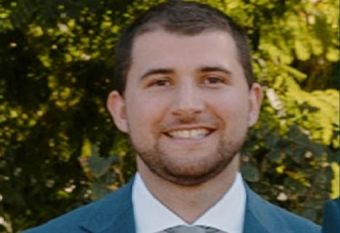
UC Santa Barbara chemical engineering PhD student Ethan McGarrigle has received the Mitsubishi Chemical Fellowship, a prestigious honor that provides financial support from 2022 through 2025. The endowed fellowship is made possible through a generous gift from the Mitsubishi Chemical Corporation to encourage outstanding doctoral students to solve the most important and pressing engineering problems of their time in any area of chemical engineering.
“I’m honored to receive the fellowship, and I am grateful to those who have helped me along the way,” said McGarrigle, a third-year PhD student, who received his bachelor’s degree in chemical engineering at the Massachusetts Institute of Technology. “I stood on the shoulders of giants to reach this point and look forward to paying it forward to those who come after me.”
Advised by chemical engineering professor Glenn Fredrickson, McGarrigle’s research examines the thermodynamics of an exotic smectic crystalline phase with superfluid character, found in spin-orbit coupled Bose gases and fluids. A superfluid is a liquid or fluid with zero viscosity — the atoms flow without viscous dissipation or internal friction. When the atoms experience temperatures near absolute zero, they behave like waves rather than particles and are best described by the laws of quantum mechanics. For assemblies of atoms obeying Bose-Einstein particle statistics, ultracold temperatures can result in a uniquely quantum phase, called a “Bose Einstein condensate,” where a majority of the atoms “condense” into the same quantum state and behave as one coherent matter wave. This condensation phenomenon helps explain how superfluidity occurs in fluids like liquid Helium.
“Systems of ultracold gases are highly tunable, making them a robust platform to design next-generation quantum technologies,” explains McGarrigle. “One example is sensing technologies, which have civil, military, and geophysical applications. Depending on the type of atom, it is also possible to design a quantum computer or quantum simulator from ultracold atoms.”
The fellowship will support McGarrigle’s research of a poorly understood phase of matter — an exotic superfluid, smectic liquid-crystalline phase found in ensembles of spin-orbit coupled atoms obeying Bose-Einstein statistics. This phase has garnered fundamental interest as a candidate “supersolid phase,” which counterintuitively, he explains, has both superfluid properties and rigid density ordering, like a liquid crystal. McGarrigle describes this state as a “stripe” phase, where the density orders in striped spatial patterns while maintaining superfluid characteristics.
“My project performs the first approximation-free simulations of this phase to date and hopes to answer the questions of whether this phase is truly ‘supersolid’ in character,” he said.
To answer the question, McGarrigle developed first-principles modeling and simulation techniques to characterize the phase. He will investigate its precise superfluid and structural properties by calculating the phase’s momentum distribution, structure factor, and its various correlation functions. He will also investigate how the stripe phase melts and undergoes phase transitions.
“Our preliminary work shows that both the superfluid and striped spatial properties melt away simultaneously!” explained McGarrigle, who also thanked his advisor, Glenn Fredrickson, and Kris Delaney, his research group’s project scientist, for their support, guidance, and patience. “The ultimate goal is to provide a phase diagram, which details the conditions during which this phase will exist at equilibrium.”
The diagram would provide engineers with a blueprint to access desired phases in spin-orbit coupled, ultracold atomic systems. This information, ultimately, facilitates the design of new quantum technologies that promise significant improvements to today’s sensing and computing capabilities.



